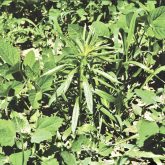Last year, calls rang out for growers and their organizations to voice their concerns about an ongoing review of hundreds of crop protection formulations. The lobbying effort carried added urgency over and above similar efforts from the previous two years.
The Pest Management Regulatory Agency (PMRA) began conducting these reviews similar to those required in the U.S. under its Food Quality Protection Act of 1996. Canada adopted the re-evaluation program in 1998, requiring all registrants to re-evaluate all pesticides on a 15-year cycle.
By 2013, roughly 150 active ingredients had been dropped from the re-evaluation process, mostly because the registrants had declined to spend the money to defend them. Still, that left more than 400 products to be re-evaluated, with another three years tacked on to the process, with warnings throughout 2015 and 2016 that more products could be dropped without appropriate entreaties to the PMRA.
Last year, individuals and organizations from different camps within the agri-food industry began turning up the volume on their warnings and protests.
That’s the backdrop for the current situation in 2018, where the urgency behind the review and its outcome have been ramped up even further. In a February 13th conference call between farm organizations and different departments within PMRA, a member of the agency’s health evaluation directorate reportedly conceded that there is a “data gap” on directives concerning post-application worker exposure, and the directorate asked for specific research be conducted to fill that gap.

It wasn’t an epiphany of any kind, according to Craig Hunter, research and crop protection specialist with the Ontario Fruit and Vegetable Growers’ Association (OFVGA). He says they’ve known of such a gap for some time. Yet it was the first time that anyone within the federal agency said there’s a problem doing the re-evaluations. In spite of its timing, Hunter believes the admission fostered the chance for a collaborative approach in working to get the necessary data into the hands of those needing it, thus speeding the process and ensuring sound scientific principles are recognized as part of re-evaluation.
“My next question was, ‘How much time do we have to get this data, so that you can go back and look at the re-evaluations before they are released as final decisions?’” says Hunter. “That’s when the head of the re-evaluation section came on the phone and said, ‘You can’t expect the PMRA to stop their work for the time that’s going to take — and it’s going to take five years to get that information — and we just can’t stop what we’re doing.’”
Read Also

Agronomists share tips for evaluating new crop products and tech: Pt. 3
With new products, new production practices and new technology converging on the agriculture industry at a frenetic pace in recent…
Hunter was stunned at the response and offered that the data gap had been recognized, and that time and effort must be committed — and funding gathered — to fill that gap and get the information for re-evaluation. The same individual from the re-evaluation section reiterated their response, emphasizing the PMRA cannot postpone its work while awaiting the data.
“We’re absolutely stunned at the attitude of this one person, and we’re prepared to use whatever it takes to get the work done, but we need time,” says Hunter.
Hunter maintains that every sector — every crop — from A to Z will be affected. This re-evaluation touches on all chemical products and has the potential to seriously restrict access to many tools that farmers have come to rely on. And contrary to the contention of the individual from the re-evaluation section, pulling together the necessary data will not require five years: with adequate funding, the needed information might be assembled in a matter of months.
But the point on any further delays is that this process has already taken too long for many of the reviews. Hunter notes the agency began its review of Captan in 2006, with little or nothing to show for it yet. What’s worse, Canada is the only jurisdiction in the world proposing these particular measures.
Potential for a purge
The current three-year delay — now poised to become four — carries with it a greater concern for due process. Is it possible that the PMRA could view the standstill and the admission of a data gap as “too big and too overwhelming” — and like a corporation declaring bankruptcy — simply wipe away all of the re-evaluations?
That is the very course that Hunter and other agri-food stakeholders fear most. Not only is there no policy in place to prevent this “purge,” it is exactly what Hunter and others believe will happen.
“Back in 1998 when the new Pest Control Products Act was written, in the preamble to the act, there was a piece in there about ‘fostering a competitive agricultural sector in Canada’ as part of its mandate,” he says. “That quietly disappeared three years ago… They just decided to take it out, they didn’t consult, they just did it.”
One review that potato growers in particular are familiar with concerns the use of Tattoo C, a fungicide that contains chlorothalonil. The proposal on its use in potatoes would allow only one use per year, yet seldom is that sufficient in the control of a disease issue. And the PMRA is trying to completely eliminate the use of Mancozeb (dithane or manzate), so what they’ve done, according to Hunter, is to take away the tools needed for growers to protect their crops without any consideration of the impact. Without Mancozeb or Bravo, growers with tomatoes will be hard-pressed to control or manage late blight.
“None of us, including any manufacturer, has heard one whisper of what the final outcomes are going to be,” says Hunter. “We sent in all kinds of support to not let this happen, but the PMRA’s re-evaluation section does all the work in total secrecy, even though they agreed to and signed a new document to say there would be further and increased consultation and a new process that was supposed to start December 1, 2016, but only on new projects. Anything we started before that date, they did it the old-fashioned way — ‘Don’t tell anybody.’”
According to Hunter, the PMRA never initiated a single new study in all of 2017. For 13 months, there was a policy in place that was never exercised.
“The impact of that new policy tells me that they clearly understand that they need to do a better job of consultation, and they haven’t,” Hunter says. “And they haven’t done it on any of the old ones and it’s the old ones that are hugely a problem for us. The consultation we had on worker exposure was great, but that wasn’t done by the re-evaluation people, it was done by the health protection people.”
Once a product is cancelled, there’s little incentive for a registrant to come back and ask to re-register. For one thing, the costs involved are excessive, meaning it’s a disincentive to renew an old active ingredient. On the horticulture side, all crops are classed as minor crops and unless there’s a huge market potential for a product in a row crop, the chances of that product being renewed by its registrant are small. Farmers simply won’t have access to them anymore.
Hunter doesn’t have an issue with protecting workers — he’s been advocating for changes to label instructions on the use of protective clothing for post-application work. But other countries that import grains and oilseeds, and fruits and vegetables are not restricting the use of these products, so current maximum residue limits (MRLs) won’t be affected from an import perspective.
“If we lose these uses because of worker protection issues, the MRLs don’t go away because it’s not a food residue issue,” says Hunter. “The PMRA cannot revoke the MRLs, so the Americans or Peruvians or Chileans can ship treated produce into Canada with the same levels of residue that they have now and have the cost of production advantage of using these products that we can’t use. And of course, the residues off our produce have to be 0.0 ppm because we’re not allowed to have any detectable limit of an unregistered pesticide.”
Yet wholesalers can import produce that does have detectable limits.
The re-evaluations for several of the products under review were supposed to have been published in March, some in June, some in July and others in the fall. But Hunter maintains that they’ve likely been written already.
















